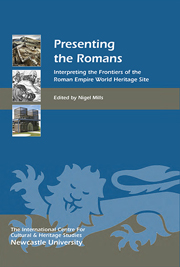17 results
List of Illustrations
-
- Book:
- Presenting the Romans
- Published by:
- Boydell & Brewer
- Published online:
- 05 September 2013
- Print publication:
- 18 July 2013, pp vii-x
-
- Chapter
- Export citation

Presenting the Romans
- Interpreting the Frontiers of the Roman Empire World Heritage Site
-
- Published by:
- Boydell & Brewer
- Published online:
- 05 September 2013
- Print publication:
- 18 July 2013
12 - Voices from the Past: Presenting (re)Constructed Environments through Multimedia Technologies
-
- Book:
- Presenting the Romans
- Published by:
- Boydell & Brewer
- Published online:
- 05 September 2013
- Print publication:
- 18 July 2013, pp 113-118
-
- Chapter
- Export citation
Contents
-
- Book:
- Presenting the Romans
- Published by:
- Boydell & Brewer
- Published online:
- 05 September 2013
- Print publication:
- 18 July 2013, pp v-vi
-
- Chapter
- Export citation
Index
-
- Book:
- Presenting the Romans
- Published by:
- Boydell & Brewer
- Published online:
- 05 September 2013
- Print publication:
- 18 July 2013, pp 199-204
-
- Chapter
- Export citation
Frontmatter
-
- Book:
- Presenting the Romans
- Published by:
- Boydell & Brewer
- Published online:
- 05 September 2013
- Print publication:
- 18 July 2013, pp i-iv
-
- Chapter
- Export citation
17 - The Hadrian's Wall Interpretation Framework: Audience Research
-
-
- Book:
- Presenting the Romans
- Published by:
- Boydell & Brewer
- Published online:
- 05 September 2013
- Print publication:
- 18 July 2013, pp 157-170
-
- Chapter
- Export citation
18 - The Hadrian's Wall Interpretation Framework
-
-
- Book:
- Presenting the Romans
- Published by:
- Boydell & Brewer
- Published online:
- 05 September 2013
- Print publication:
- 18 July 2013, pp 171-180
-
- Chapter
- Export citation
Acknowledgments
-
- Book:
- Presenting the Romans
- Published by:
- Boydell & Brewer
- Published online:
- 05 September 2013
- Print publication:
- 18 July 2013, pp xi-xi
-
- Chapter
- Export citation
19 - Applying the Hadrian's Wall Interpretation Framework
-
-
- Book:
- Presenting the Romans
- Published by:
- Boydell & Brewer
- Published online:
- 05 September 2013
- Print publication:
- 18 July 2013, pp 181-192
-
- Chapter
- Export citation
14 - Information, Disinformation and Downright Lies: Portraying the Romans
-
- Book:
- Presenting the Romans
- Published by:
- Boydell & Brewer
- Published online:
- 05 September 2013
- Print publication:
- 18 July 2013, pp 129-138
-
- Chapter
- Export citation
List of Contributors
-
- Book:
- Presenting the Romans
- Published by:
- Boydell & Brewer
- Published online:
- 05 September 2013
- Print publication:
- 18 July 2013, pp 193-198
-
- Chapter
- Export citation
List of Abbreviations
-
- Book:
- Presenting the Romans
- Published by:
- Boydell & Brewer
- Published online:
- 05 September 2013
- Print publication:
- 18 July 2013, pp xii-xii
-
- Chapter
- Export citation
Preface
-
- Book:
- Presenting the Romans
- Published by:
- Boydell & Brewer
- Published online:
- 05 September 2013
- Print publication:
- 18 July 2013, pp xiii-xiv
-
- Chapter
- Export citation
Heritage Matters
-
- Book:
- Presenting the Romans
- Published by:
- Boydell & Brewer
- Published online:
- 05 September 2013
- Print publication:
- 18 July 2013, pp 205-205
-
- Chapter
- Export citation
The structure of work environments in psychiatric rehabilitation: Therapeutic alternatives to the industrial workshop
-
- Journal:
- Psychiatric Bulletin / Volume 15 / Issue 2 / February 1991
- Published online by Cambridge University Press:
- 02 January 2018, pp. 69-72
- Print publication:
- February 1991
-
- Article
-
- You have access
- Open access
- Export citation
Luni and the Ager Lunensis: The Rise and Fall of a Roman Town and its Territory
-
- Journal:
- Papers of the British School at Rome / Volume 54 / November 1986
- Published online by Cambridge University Press:
- 09 August 2013, pp. 81-146
- Print publication:
- November 1986
-
- Article
- Export citation



